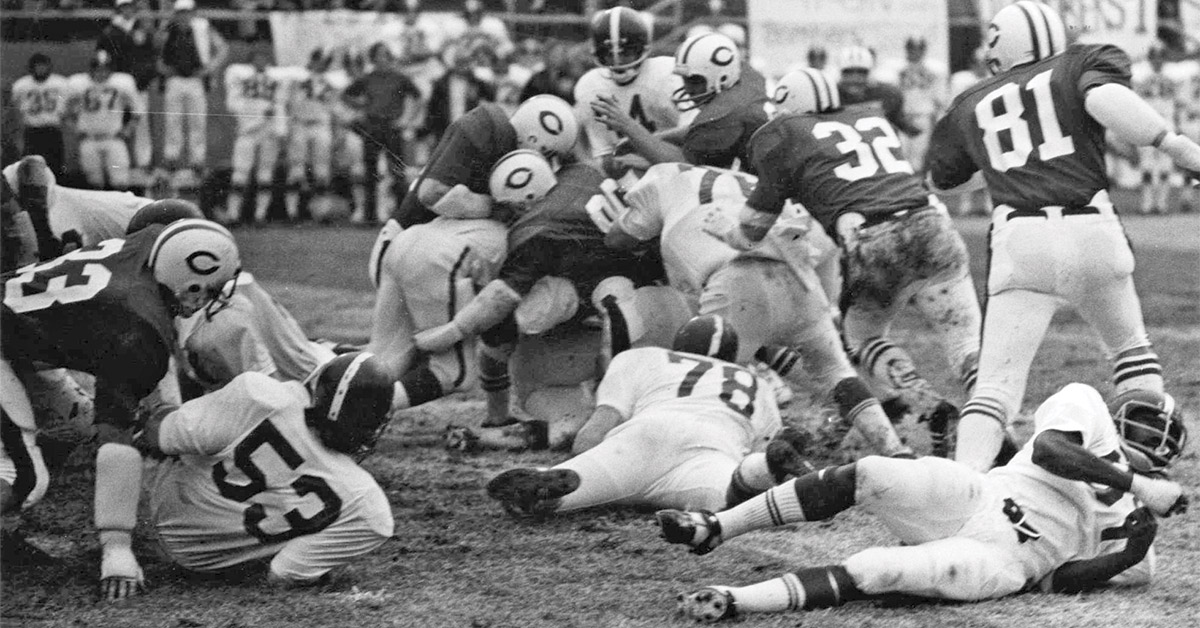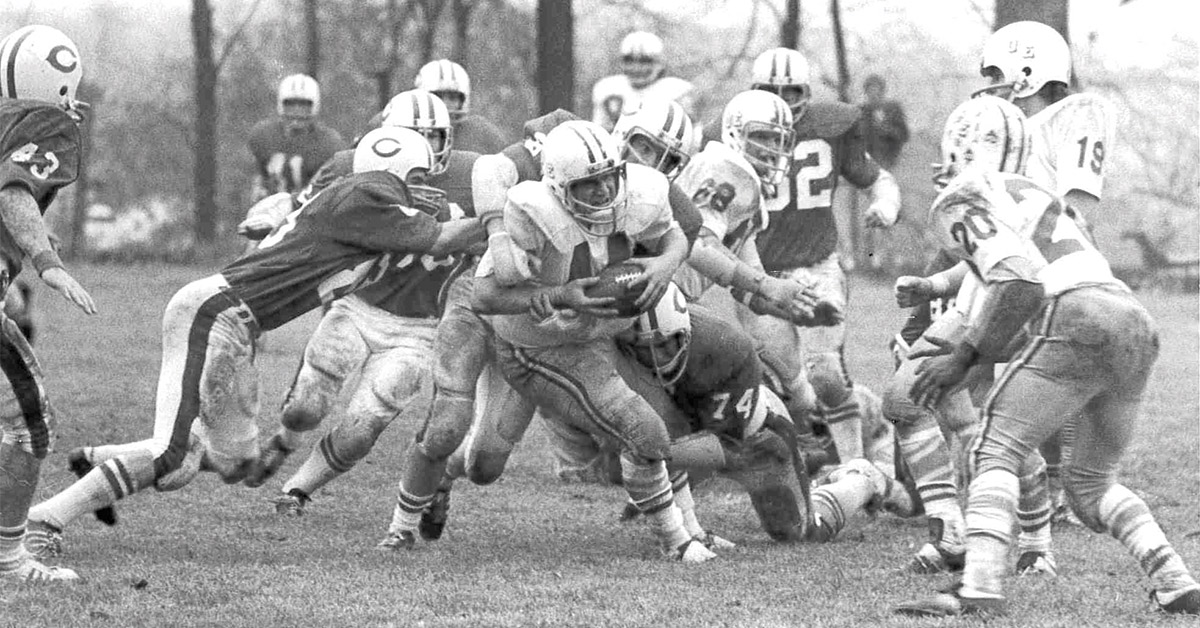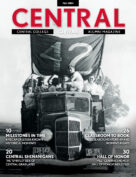
A teeth-rattling defense kept Ithaca College under wraps and carried Central College to a 10-8 triumph in the Amos Alonzo Stagg Bowl in Phenix City, Alabama, giving the Dutch the 1974 NCAA Division III football crown.
Fourth and one.
In hindsight, even more than an NCAA Division III football championship hinged on that next play 50 years ago. The story is a familiar one to Central College fans. It was 1974 and Central was clinging to a 10-6 lead over heavily favored Ithaca College late in the fourth quarter in the Amos Alonzo Stagg Bowl in Phenix City, Alabama. The high-powered Bombers reached the Central six-yard line as the clock ticked down. The Dutch, of course, ultimately prevailed 10-8 and the gray-haired team members who returned to campus for a 50th-anniversary celebration Sept. 20-22 were a reminder that, in a way, that play and that win represent more than a red banner that now clings to the east wall of P.H. Kuyper Gymnasium. It also ushered in an era of unprecedented athletics success for the college.
Success Unleashed
Central’s athletics tradition was already well-established. But the 1974 win seemingly unleashed a torrent of titles. Prior to 1974, Central won 18 conference championships. Over the next 50 years, the Dutch claimed 170 — a period that also spawned Central’s other 10 national team titles, all 37 of the school’s individual NCAA Division III crowns and 510 of Central’s 518 all-America awards.
Beyond that, the championship pushed Coach Ron Schipper into the Division III spotlight, propelling him to top-choice NCAA committee assignments, including the powerful TV Committee. This eventually led to him serving as president of the American Football Coaches Association followed by his induction into the College Football Hall of Fame.
Ken Weller, then in his fifth year as Central’s president, caught the eye of NCAA officials in Phenix City that week. Impressed not only with his leadership qualities but also with his appreciation for Division III and intercollegiate athletics, it put him on a path to eventually author the original Division III philosophy, as well as gain a seat on the inaugural Presidents’ Commission and a term as Division III vice president. His influence also helped former Dean of Students Marjorie Giles become the first female president of the Iowa Conference and later gain membership on the NCAA Council. The victory gave new momentum to the development of the A.N. Kuyper Athletics Complex as well, with what is now Ron and Joyce Schipper Stadium opening in 1977 and other facilities following.
Team captain Al Dorenkamp ’75, who gained all-America honors as a linebacker that year, served as Central’s athletics director from 1998-2012, and saw the connection.
“No question about that,” he affirms. “When Dr. Weller was around, he’d always come to these reunion banquets and say, ‘I just want to thank you guys as 1974 national champions because you opened the door for a guy like me to get more involved in the NCAA at the administrative level.’ I certainly think that championship was sort of a springboard for Central College.”
Say No More
None of that was on the minds of Central’s tougher-than-gristle defenders as they dug into the brightly painted Alabama turf that December afternoon. Ithaca entered the game averaging 43.6 points and a Division III-best 487.9 yards per game. But Central’s defense, largely comprised of underrecruited, undersized yet overachieving rural Iowa players, somehow kept the Bombers in check. As 1,000-yard running back Dave Remick and the Ithaca offense huddled, Dorenkamp’s message to the Central defense was simple.
“I told the guys in the huddle that this was the reason we were here,” Dorenkamp told a reporter following the game. “I told them the national title was riding on this play. That was all I said because I figured if that didn’t fire them up, nothing would.”
Feisty defensive lineman Mike Street ’75 didn’t need any extra motivation.
“I told myself, ‘This is it,’” Street recalls. “‘This is what we’ve been working for all year. We’ve come too far to blow it now.’”
An ABC national television audience — back in the days of only three TV networks — looked on as Remick took the quick handoff at fullback and was immediately engulfed by a swarm of Dutch defenders.
“I don’t think he made it,” shouted color commentator Duffy Daugherty, the former Michigan State coach who was the Kirk Hebstreit of his day. “I don’t think he made it!”
He didn’t. It wasn’t clear then who the tackler was and even less so on the grainy video. Some credit Dorenkamp. He insists there were others. But the officials didn’t even need a measurement. The Dutch defense had held.
Schipper, who seldom let the NCAA trophy out of his grasp throughout the trip home, told the Des Moines Register that the goal line stand “exemplified the whole season for us. They had to get the job done and they got it done.”

Central pulled off a 17-16 road upset against University of Evansville when Mike Street ’75 blocked an extra point with just over one minute remaining.
An Iconic Scene
Fifty years. Most of the starters are now in their 70s and the play still shines in their collective memory banks. Yet several other moments stand out as well. For many, the magic of that iconic season can be summed up in three words: Cutler to Busscher. The connection reached its zenith in game two.
After shutting out defending NAIA champion Northwestern College 19-0 in the season opener, the Dutch then had to tackle Division II Ferris State College, which somehow landed on Central’s schedule. As fullback Mike Hodges ’75 pushed his tray along the metal serving line rails for the pregame meal in the old Graham Dining Hall, another player pondered the match-up and quietly asked him, “Do you suppose maybe Coach Schipper bit off more than he can chew with this game?”
Still, Central took a 15-10 lead over the Bulldogs with 3:42 left, only to have Ferris State strike with just 32 seconds remaining to go up 17-15. Many fans shrugged disappointedly and headed for the exits.
But the Dutch still had one button left to push: Randy Busscher ’75, who had already caught a 42-yard first-half TD pass. Busscher, later named to the Central Athletics Hall of Honor, set several school receiving records.
“He’s the best wide receiver Central has ever had, I don’t care what anybody says,” Hodges declares.
Quarterback Gary Cutler ’75 knew what he wanted to do.
“I looked at (offensive coordinator Dick Bowzer) on the sideline and asked, ‘49 reverse pass?’” Cutler remembers. “And he kind of shook his head.”
From his own 23-yard line, Cutler found the flashy wide receiver streaking down the field for a game-winning 77-yard touchdown with eight seconds to spare.
“Everybody knew what play we were going to run,” Schipper said. “The pro scouts always told us that Busscher wasn’t fast, but all I know is that Ferris State had a Michigan state sprint champion at free safety, and he couldn’t catch Busscher on that play.”
Ironically, Busscher and that defensive back briefly met again as teammates at the Minnesota Vikings preseason training camp the following summer.
The breaks didn’t all go Central’s way, however. Three games later the Dutch endured a devastating one as Busscher was lost for the season with a shoulder injury. Yet the championship train rolled on.
“You take away our best player and we win the next six, that says something,” Schipper said.
A season-ending showdown with William Penn was one for the ages. The heated century-old rivalry with the school from just 17 miles down the road was at its peak. Penn was still an NCAA member, ranked third in the nation. Both teams entered the game unbeaten with the Iowa Conference championship on the line and Schipper often claimed the overflow crowd that circled the cinder track at old A.N. Kuyper Field that day was the largest in Central history. Cornerback Tim Piester ’75 returned a fumble 36 yards for a score as Central took a 14-0 first-quarter lead and the defense pitched a second-half shutout for a 23-14 win to complete an undefeated season.
Players anxiously wondered if there was more to come. Only four teams were picked for the Division III playoff field and little-known Central’s status was unclear. The team held its post season awards banquet the following week before landing the final playoff spot, traveling to the University of Evansville.
Central mustered just 127 yards total offense yet led the Aces 17-10 late in the fourth quarter. The Dutch averted one threat after Evansville reached the 8-yard line when they forced a fumble pounced on by Street with 2:14 left. But given a final chance less than a minute later, the Aces hit on a 51-yard TD pass and were an extra point away from forcing a likely overtime.
Street, whose fierce determination personified that of the 1974 squad, turned to Schipper with a “Hold my Gatorade” look.
“He told me before the play, ‘I’m going to block the extra point,’” Schipper recalled years later. “He knew that offensive tackle because he’d studied him in the films and he went in scot-free and blocked it.”
Central was a 17-16 winner, setting up the program-defining Stagg Bowl appearance in Alabama.

Sporting the era’s wide ties and belts to go with the bright red sportscoats Coach Ron Schipper required the team to wear on road trips, Les Hogan ’77 (left) and Marc Cramer ’77 make a jubilant post-midnight return to Kuyper Gymnasium after the Stagg Bowl victory.
Rooted in Significance
But what if Cutler had overthrown Busscher against Ferris State? What if Street couldn’t get past the Evansville offensive tackle? What if Ithaca had scored on fourth-and-one? A half-century later, would these players’ lives be any different? The logical answer, of course, is no. It’s only a game, right? Yet when asked, with the perspective gained from losing hair, gaining grandchildren and replacing hips, the grads invariably pause before answering.
“That goal-line stand showed me what you can do when you are really part of a team and everyone on that team’s pulling in the same direction,” defensive back Al Paris ’77 shares. “That solidified for me how important teamwork and relationships are in my career. I worked for (John Deere and Company) for almost 40 years and I tried to build relationships that were based on mutual respect. And I think that’s a result of what I learned from the outcome of that game.”
And it’s the connections from that special season that endure, even as the memories fade.
“Your love for the college is the same as it was 50 years ago,” Paris says. “The friendships that came out of that team are incredible. We’re as close as we were 50 years ago, and I think that’s a result of that season.”
Fifty years. So much has changed. Today’s Central coaches and players are largely unfamiliar. The Vermeer Science Center now stands in what used to be the old Kuyper Field west end zone. And they don’t even call it the Iowa Conference anymore. Yet the emotions are fresh. The sight of 100-plus bright red jerseys on the Central sidelines, their beloved coach’s statue in the stadium that now bears his name, the first few chords of their 1974 anthem “Sweet Home Alabama” and “Hoo-Rah! Hoo-Rah!” following the singing of “CUI” all bring the feelings rushing back, that same familiar tingle of excitement they felt every time they sprinted onto the field on chilly fall Saturday afternoons.
But time has softened the laser focus the players once placed on the scoreboard.
“The significance of winning that game is maybe not as great as it once was; what’s more significant to me is why we won,” Cutler explains. “And I think that has to do more with the collective character of the team than the athletic ability of the team members.”
“(Retired Alabama coach) Nick Saban said who you are is more important than what you do. I think he recognized that if he had kids with character, the winning would take care of itself. I look at the people on that team, and I see people who had compassion toward others and people who spent their careers working to help others. That’s what is significant to me.”
Spring Sports Updates
Baseball: Central finished seventh in the league (16-23 overall, 10-14 conference). Outfielder Colton DeRocher ’24 and pitcher Mark Kenney ’26 were each second-team all-conference picks. DeRocher broke the school career home runs record with 25.
Cheer and Dance: Central’s cheerleading and dance teams competed at the NDA/NCA College Nationals in Daytona Beach, Florida. The cheer team placed eighth in the Spirit Rally Open Division while dance took home second overall and third-place titles, in Pom and Jazz Division III, respectively.
Men’s golf: Central came in third in the league tournament. Jacob Moffett ’24 was the conference tournament runner-up while Harold Dobernecker ’25 was ninth, gaining all-conference distinction for the fourth time.
Softball: The Dutch (33-13 overall, 13-3 conference) captured their 14th conference championship and 15th NCAA Division III regional crown, losing in the super regional at Linfield University while making a record 32nd tournament appearance. Central was No. 14 in the final national rankings. Second baseman Haley Bach ’25 was a second-team all-America honoree. Emma Beck ’27 was the conference pitcher of the year.
Men’s tennis: Central placed fourth in the conference (9-13 overall, 5-3 conference). Ayden Fletcher ’25 was an all-conference singles pick and AJ Wilkins ’25 was cited in doubles.
Men’s track and field: Central was fourth at the conference meet and tied for 63rd at the NCAA Division III Championships in Myrtle Beach, South Carolina. Gavin Smith ’26 was an all-America honoree, placing sixth in the decathlon.
Women’s track and field: Central was eighth at the NCAA Division III Championships in Myrtle Beach, South Carolina, the program’s highest finish since 1984. Megan Johnson ’24 claimed the national title in the 3,000-meter steeplechase, followed closely in second by Caroline McMartin ’24 with Addison Parrott ’25 seventh. McMartin was sixth in the 5,000.
Academic All-America: A record seven Central athletes were named to the CSC Academic All-America Teams® this spring. McMartin, Johnson, Abbi Roerdink ’24 and Olivia Bohlen ’26 were cited in women’s track and field; Noah Jorgenson ’24 and Smith were tabbed in men’s track and field; and wrestler Gage Linahon ’24 was named to the men’s at-large team. McMartin also became the 27th athlete in school history to receive an NCAA postgraduate scholarship.












To encourage serious, intellectual discourse on Civitas, please include your first and last name when commenting. Anonymous comments will be removed.
John Robert Hanna
|
6:55 am on November 20, 2024
Larry .. thank you so much for the column on the 50th Anniversary Reunion of the National Football Division III Champions.You truly captured the feeling & accomplishments of that team. Expertly worded and completed. Many many thanks for all your years at Central, Larry. OoRah.! Central Central Rah Rah..!!